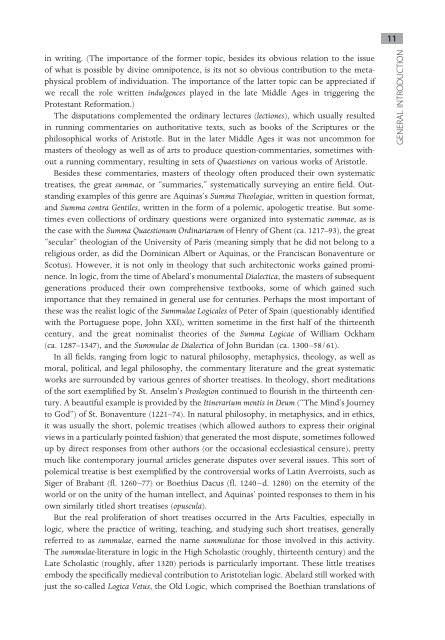Blackwell Readings in Medieval Philosophy - Fordham University ...
Blackwell Readings in Medieval Philosophy - Fordham University ...
Blackwell Readings in Medieval Philosophy - Fordham University ...
You also want an ePaper? Increase the reach of your titles
YUMPU automatically turns print PDFs into web optimized ePapers that Google loves.
MP_A02.qxd 11/17/06 5:26 PM Page 11<br />
<strong>in</strong> writ<strong>in</strong>g. (The importance of the former topic, besides its obvious relation to the issue<br />
of what is possible by div<strong>in</strong>e omnipotence, is its not so obvious contribution to the metaphysical<br />
problem of <strong>in</strong>dividuation. The importance of the latter topic can be appreciated if<br />
we recall the role written <strong>in</strong>dulgences played <strong>in</strong> the late Middle Ages <strong>in</strong> trigger<strong>in</strong>g the<br />
Protestant Reformation.)<br />
The disputations complemented the ord<strong>in</strong>ary lectures (lectiones), which usually resulted<br />
<strong>in</strong> runn<strong>in</strong>g commentaries on authoritative texts, such as books of the Scriptures or the<br />
philosophical works of Aristotle. But <strong>in</strong> the later Middle Ages it was not uncommon for<br />
masters of theology as well as of arts to produce question-commentaries, sometimes without<br />
a runn<strong>in</strong>g commentary, result<strong>in</strong>g <strong>in</strong> sets of Quaestiones on various works of Aristotle.<br />
Besides these commentaries, masters of theology often produced their own systematic<br />
treatises, the great summae, or “summaries,” systematically survey<strong>in</strong>g an entire field. Outstand<strong>in</strong>g<br />
examples of this genre are Aqu<strong>in</strong>as’s Summa Theologiae, written <strong>in</strong> question format,<br />
and Summa contra Gentiles, written <strong>in</strong> the form of a polemic, apologetic treatise. But sometimes<br />
even collections of ord<strong>in</strong>ary questions were organized <strong>in</strong>to systematic summae, as is<br />
the case with the Summa Quaestionum Ord<strong>in</strong>ariarum of Henry of Ghent (ca. 1217–93), the great<br />
“secular” theologian of the <strong>University</strong> of Paris (mean<strong>in</strong>g simply that he did not belong to a<br />
religious order, as did the Dom<strong>in</strong>ican Albert or Aqu<strong>in</strong>as, or the Franciscan Bonaventure or<br />
Scotus). However, it is not only <strong>in</strong> theology that such architectonic works ga<strong>in</strong>ed prom<strong>in</strong>ence.<br />
In logic, from the time of Abelard’s monumental Dialectica, the masters of subsequent<br />
generations produced their own comprehensive textbooks, some of which ga<strong>in</strong>ed such<br />
importance that they rema<strong>in</strong>ed <strong>in</strong> general use for centuries. Perhaps the most important of<br />
these was the realist logic of the Summulae Logicales of Peter of Spa<strong>in</strong> (questionably identified<br />
with the Portuguese pope, John XXI), written sometime <strong>in</strong> the first half of the thirteenth<br />
century, and the great nom<strong>in</strong>alist theories of the Summa Logicae of William Ockham<br />
(ca. 1287–1347), and the Summulae de Dialectica of John Buridan (ca. 1300–58/61).<br />
In all fields, rang<strong>in</strong>g from logic to natural philosophy, metaphysics, theology, as well as<br />
moral, political, and legal philosophy, the commentary literature and the great systematic<br />
works are surrounded by various genres of shorter treatises. In theology, short meditations<br />
of the sort exemplified by St. Anselm’s Proslogion cont<strong>in</strong>ued to flourish <strong>in</strong> the thirteenth century.<br />
A beautiful example is provided by the It<strong>in</strong>erarium mentis <strong>in</strong> Deum (“The M<strong>in</strong>d’s Journey<br />
to God”) of St. Bonaventure (1221–74). In natural philosophy, <strong>in</strong> metaphysics, and <strong>in</strong> ethics,<br />
it was usually the short, polemic treatises (which allowed authors to express their orig<strong>in</strong>al<br />
views <strong>in</strong> a particularly po<strong>in</strong>ted fashion) that generated the most dispute, sometimes followed<br />
up by direct responses from other authors (or the occasional ecclesiastical censure), pretty<br />
much like contemporary journal articles generate disputes over several issues. This sort of<br />
polemical treatise is best exemplified by the controversial works of Lat<strong>in</strong> Averroists, such as<br />
Siger of Brabant (fl. 1260–77) or Boethius Dacus (fl. 1240–d. 1280) on the eternity of the<br />
world or on the unity of the human <strong>in</strong>tellect, and Aqu<strong>in</strong>as’ po<strong>in</strong>ted responses to them <strong>in</strong> his<br />
own similarly titled short treatises (opuscula).<br />
But the real proliferation of short treatises occurred <strong>in</strong> the Arts Faculties, especially <strong>in</strong><br />
logic, where the practice of writ<strong>in</strong>g, teach<strong>in</strong>g, and study<strong>in</strong>g such short treatises, generally<br />
referred to as summulae, earned the name summulistae for those <strong>in</strong>volved <strong>in</strong> this activity.<br />
The summulae-literature <strong>in</strong> logic <strong>in</strong> the High Scholastic (roughly, thirteenth century) and the<br />
Late Scholastic (roughly, after 1320) periods is particularly important. These little treatises<br />
embody the specifically medieval contribution to Aristotelian logic. Abelard still worked with<br />
just the so-called Logica Vetus, the Old Logic, which comprised the Boethian translations of<br />
11<br />
GENERAL INTRODUCTION

















